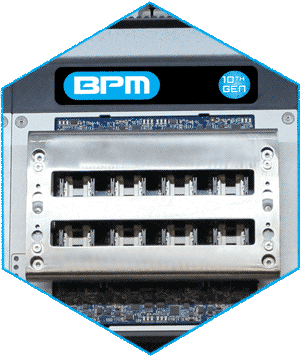Socket |
noun |
| sä-kət | |
| Definition of socket: | an opening or hollow that forms a holder for something |
| Source: | Merriam-Webster |
“Socket” can mean different things depending on the context. Even in just electronics, “sockets” can mean more than one thing.
When BPM uses the term “socket,” it is referring to the electro-mechanical interface between the BPM programmer and the programmable device.
BPM pioneered using socket adapters to increase the usefulness of their programmers. In the “old” days, you had to buy a programmer for each type of device needed (which might mean a new programmer for a different pin count). Socket Adapters are the mechanical “bridge” between the programmer’s programming site and the device to be programmed. A software algorithm is needed as well, which directs where the packets of data go. Most programmers sold in the last 15 years or so use adapters.
 There are two main components on an adapter: A circuit board with connector pins that insert into the programmer’s site, and a socket receptacle. The circuit board, due to its structure, is unlikely to fail before millions of insertions. There are no “mechanical” parts, with the exception of the connectors. Not so with the receptacle. The receptacle is “closed” in its resting state. In order to open the receptacle to insert a device, pressure is applied to the top (either by hand, by a lever, or by a pressure plate in an automated system). Some large device sockets utilize a clam-shell top to close. Receptacles, due to their mechanical nature, are subject to failure after a certain number of insertions. For standard socket receptacles, you can expect anywhere from 5,000 to as many as 25,000 insertions. High insertion sockets (HIC) are rated for 250,000 insertions.
There are two main components on an adapter: A circuit board with connector pins that insert into the programmer’s site, and a socket receptacle. The circuit board, due to its structure, is unlikely to fail before millions of insertions. There are no “mechanical” parts, with the exception of the connectors. Not so with the receptacle. The receptacle is “closed” in its resting state. In order to open the receptacle to insert a device, pressure is applied to the top (either by hand, by a lever, or by a pressure plate in an automated system). Some large device sockets utilize a clam-shell top to close. Receptacles, due to their mechanical nature, are subject to failure after a certain number of insertions. For standard socket receptacles, you can expect anywhere from 5,000 to as many as 25,000 insertions. High insertion sockets (HIC) are rated for 250,000 insertions.
BPM does not limit the number of insertions on its sockets (many of our competitors do). We do give the operator a warning that a socket has reached its factory-expected life.
Most BPM sockets come with a receptacle base. Receptacle-base socket modules and socket cards include a receptacle interface between the printed circuit board and the socket. This allows you to replace only the individual consumable socket once it reaches its useful life. This has proven to extend the life of the socket module and socket card, producing higher yields and lowering programming cost per device.
3 Classes of Adapters
BPM designs and produces a variety of socket adapters, and offers three classes of socket adapters:
 |
Socket Modules (Legacy Adapters)
|
 |
D-Cards (Daughter card replacement assembly)
|
 |
Socket Cards
|
Gang Adapters
 FVXG adapters are gang adapters that are only compatible with 10th Generation programmers.
FVXG adapters are gang adapters that are only compatible with 10th Generation programmers.- All sockets share the same pc board on a gang adapter
- FVXG8 is a gang 8 adapter with 8 sockets per board.
- FVXG6 is a gang 6 adapter with 6 sockets per board.
- Similarly, BPM could design FVXG2 (two up), FVXG3 (three up), FVXG4 (four up), or FVXG5 (five up) adapters.
- IMPORTANT: The pressure plates used for 10th Gen automated programmers are heavier gauge stainless steel than the pressure plates used for all other Generation programmers. The pressure required to open up to 8 sockets is double that required for 4-sockets per site automated programmers.
BPM Device Programmers | Socket Modules/Socket Cards | Socket Name Decoder | Extend Socket Life Article | Buy Sockets
